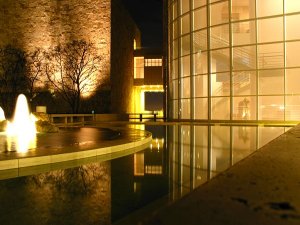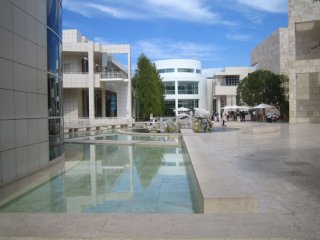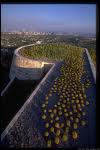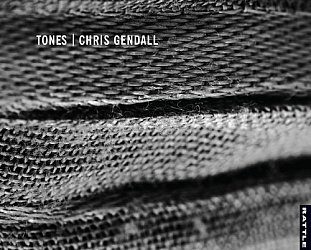Graham Reid | | 6 min read

High in the hills overlooking Los Angeles, The Getty Centre offers
a commanding view.
“Yeah, on a clear day you can see smog forever,” says a droll
Angelino as he stares into the blue-grey gauze which lies lightly
over his city on this typically perfect, dry day.
That said the Getty, as it is commonly known and which opened 18
months ago, is beautifully appointed on a 46ha site above the San
Diego Freeway in Brentwood. It looks from the Pacific Ocean and
across the greater Los Angeles area in one direction, and to the
Santa Monica Mountains in another.
Little wonder Angelinos sometimes come here to simply wander
through the gardens -- designed by Robert Irwin -- and have lunch in
the sun with the busy world far beneath their sight-lines. Up here
it’s sky above and world below -- and art all around.
Built for about $NZ1.75 billion, the Getty art museum has seen
more that two million visitors since its opening in December 1997.
And oddly in this city of the automobile, the carpark allows for only
700 vehicles so it pays to book ahead. The many visitors who arrive
by bus or taxi -- or on skateboards or in-line skates, because this
is Los Angeles after all -- don’t need reservations.
The Getty certainly rewards any effort made to get to it.
Designed by Richard Meier, the centre effects the marriage of
handsome design and functionalism. Meier’s vision and the Southern
Californian climate has allowed for that rarity in art museums, an
effortless union of interior and exterior space.
Paintings on the top floors are exhibited under natural light.
The Getty is considered one of the great museums and locations --
but Meier’s bull-headed vision to realise his dream, and the
museum’s future direction, have been the stuff of protracted
controversy.
Of current concern is the Getty’s acquisitions policy most
recently under fire from Los Angeles Times’ art critic Christopher
Knight, who berated the museum for letting Georges Seurat’s 1884
Landscape, Island of Grande Jatte slip through its fingers.
Knight rightly noted that Seurat is internationally regarded as
one of the finest by the French pointillist Impressionist. This
painting was the perfect and necessary counterpoint to the Getty’s
Entry of Christ into Brussels in 1889 by James Ensor, a powerful
Expressionist work the museum snapped up a little over l0 years ago.
The Seurat, however, is now in Steve Wynn’s collection in his
Las Vegas casino, Bellagio. He picked it up for a tidy $NZ70 million.
The Getty says it considered bidding for it, but determined it
wasn’t a good enough example of the artist’s work -- a
breathtaking assertion. Knight suggests the museum’s running costs
(“a voracious money pit") meant it simply didn’t have the
readies for such a major purchase.
In a front-page Times article Knight noted that while the museum
was bolstered by a trust with an annual endowment of $NZ10 billion,
there were enormous outgoings.
The Getty has six principal buildings which collectively house the
J. Paul Getty Museum, offices, an auditorium, conservation institute,
the Getty Research Institute for the History of Art and the
Humanities, an education institute for the arts, the Getty
Information Institute, the Getty Grant Programme, and a restaurant
and cafe.
lt is impressively large, as befits what has been described as the
most expensive and extravagant museum in the United States.
With facades of rough travertine stone chosen to evoke
traditionalism and endurance (though a substitute for the architect's
original concept of white enameled aluminium after complaints from
the neighbours), the place has a cool, assured ambience and sits
comfortably within the topography of the sometimes arid Californian
hills.
The Getty is expansive enough to accommodate large exhibitions.
Running at present are extensive exhibitions by the photographer
Brassai, the intelligent and informative pairing of the Italian
renaissance painters Ercole de Roberti and Dosso Dossi (complete with
x-ray analysis of one of Dossi’s larger works), an impressive
display of medieval illustrated manuscripts with educative displays
on book illustration and construction, sculpture exhibits, and more.
Already this year there have been acclaimed exhibitions of Dance and
Photography, the seldom seen photography of Edgar Degas, some small
Van Goghs, and changing displays from the museum's extensive archives
and collections. And most of these exhibits come with explanatory
notes and tie-in education programmes.
But the Getty did not arrive at this point without its
shortcomings or critics.
Meier, a visionary Modernist architect, drove his particular
vision of the museum for 14 years and clashed repeatedly with almost
everyone eise involved, notably Irwin and museum director John Walsh.
A behind-the-scenes documentary about this titanic struggle of
ideas, ideologies and egos, Concert of Wills: Making the Getty
Centre, captures the drama.
But despite Meier’s genius being largely realised -- and the
finished complex greeted with critical and public acclaim --
attention has turned to what is in the galleries. And, as Knight
pointed out, what is not.
Some say the feast of art can quickly turn into a smorgasbord, and
the slightly chaotic permanent exhibition largely reflects the
idiosyncratic taste of its benefactor, the late oil tycoon J. Paul
Getty.
The gardens -- a source of a lengthy dispute between Meier and
Irwin -- may be impressive in Los Angeles, a city not known for its
proud domestic gardens, but to outsiders it can look little more than
a well-designed, constrained collection. Plants which line the
zig-zag path that crosses over a trickling stream and leads to a
concentric display are regularly changed. But when lined up against
the great museum gardens of the world, it can look meagre.
And despite its size, the Getty is already cramped and the trust
has had to lease additional, expensive space in nearby Santa Monica.
It is also having to look at adding more parking spaces, there are
continuing renovations to Getty’s original villa in Malibu which is
scheduled to open in 2001, the numerous research and conservation
programmes are draining money and it demands a large staff.
The year before the Getty Centre opened the museum’s
acquisitions budget was slashed from $NZ92 million to $NZ50 million
and the figure is even lower today.
As a result, since its opening the museum's acquisitions have been
unimpressive. Knight listed only two major paintings, four
sculptures, three plaques, a Byzantine manuscript, 123 photographs
and other smaller works.
Certainly there have been generous gifts and endowments, but the
Getty itself appears to letting acquisition opportunities go by while
it struggles with its day-to-day running costs and problems.
So impressive though the Getty Centre may be -- and it is
certainly that -- there is also disquiet as to its future direction.
Whether what's inside continues to match its impressive exterior is
the question.







post a comment